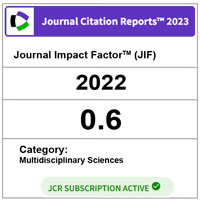Optimization process of moringa oleifera seed extract using artificial neural network (ANN)
DOI:
https://doi.org/10.11113/mjfas.v15n2.1104Abstract
The use of chlorine which causes disinfection of by-products is a major concern especially in the developed countries. There is the need to look for a cheap alternative such as the use of plant material as substitute for chemical disinfectant. Moringa oleifera is an extensively documented plant material used for the treatment of drinking water. Its seed extracts contain active agents that having excellent coagulation properties and exerting in-vitro bactericidal activity. However, lack of available literature on the statistical optimization using artificial neural network (ANN) for inactivation kinetics of the seed extract using different disinfection models is the major aspect that need to be explored. This study was conducted to develop operation parameters using ANN for the seed extracts to be used as disinfectant for water treatment. The optimization process based on statistical experimental design using artificial neural network (ANN) in MATLAB 2012A was used to identify and determine the optimum process conditions. The multivariate regression analysis of the disinfection kinetic models was analyzed using SPSS version 20 and the final application of the optimized process conditions with river water was evaluated. The statistical analysis of optimization results using ANN gave a high coefficient of determination (R2) of 0.9992 and 0.9886 for E.coli. The model developed was verified and the optimum process parameters were 124 mg/L dosage, 65 minutes of contact time, 110 rpm mixing rate for E.coli bacterial strain. The order of reaction followed second order and the inactivation kinetics showed that modified Hom model was best fitted the disinfection process with R2 of 0.711. The findings from the application of the seed extract to river water showed that the removal efficiency for the seed extract with over 99.98% reduction of heterotrophic bacteria after the disinfection process. Hence, the findings of this study showed that defatted Moringa oleifera seed extract using the salt extraction method could be used as a disinfectant. This extract was recommended to be used in small communities and in emergency situations.
References
Alvarez, E. G. 2006. Artificial Neural Networks. Retrieved from http://edugi.unimuenster.de/eduGI.LA2/downloads/02/ArtificialNeuralNet
works240506.pdf
Arnoldsson, E., Bergman, M., Matsinhe, N., Persson, K. M. 2008. Assessment of drinking water treatment using moringa oleifera natural coagulant. Vatten, 64, 137-150.
Azzellino, A., Antonelli, M., Canziani, R., Malpei, F., Marinetti, M., Nurizzo, C. 2011. Multivariate modelling of disinfection kinetics: A comparison among three different disinfectants. Desalination and Water Treatment, 29, 1-3, 128-139.
Bichi, M. H., Agunwamba, J. C., Muyibi, S. A. 2012. Optimization of operating conditions for the application of moringa oleifera (zogale) seeds extract in water disinfection using response surface methodology. African Journal of Biotechnology, 11, 92, 15875-15887.
Demuth, H., Beale, M., Hagan, M. 2008. Neural network toolbox 5 user’s guide. Retrieved from file:///C:/Users/User/Downloads/MATLAB_-_Neural_Network_Toolbox_5_-_Users_Guide_2007.pdf
Desai, K. M., Survase, S. A., Saudagar, P. S., Lele, S. S., Singhal, R. S. 2008. Comparison of artificial neural network (ANN) and response surface methodology (RSM) in fermentation media optimization: Case study of fermentative production of scleroglucan. Biochemical Engineering Journal, 41, 3, 266-273.
Ferreira, R. S., Napoleão, T. H., Santos, A. F. S., Sá, R. A., Carneiro-da-Cunha, M. G., Morais, M. M. C., et al. 2011. Coagulant and antibacterial activities of the water-soluble seed lectin from moringa oleifera. Letters in Applied Microbiology, 53, 2, 186-192.
Haykin, S. 1999. Neural Networks: A Comprehensive Foundation. McMaster University, Ontario Canada: Pearson.
Kumar, V. K., Rubha, M. N., Manivasagan, M., Babu, R., Balaji, P. 2012. Moringa oleifera - the nature’s gift abstract. Universal Journal of Environmental Research and Technology, 2, 4, 203-209.
Lippmann, R. P. 1987. An introduction to computing with neural nets. IEEE ASSP Magazine, 3, 4, 4-22.
Madrona, G. S., Branco, I. G., Seolin, V. J., Alves Filho, B. D. A., FagundesKlen, M. R., Bergamasco, R. 2012. Evaluation of extracts of moringa oleifera lam seeds obtained with nacl and their effects on water treatment. Acta Scientiarum. Technology, 34, 3, 289-293.
Mahajan, R. K., Walia, T. P., Lark, B. S., Sumanjit. 2006. Analysis of physical and chemical parameters of bottled drinking water. International Journal of Environmental Research and Public Health, 16, 2, 89-98.
Muyibi, S. A., Birima, A. H. M., Mohammed, T. A., Noor, M. J. M. M. 2004. Conventional treatment of surface water using moringa oleifera seeds extract as a primary coagulant. IIUM Engineering Journal, 5, 1, 25-35.
Mwh. 2005. Water treatment: Principles and Design (Second Edi ed.). United States of America: John Wiley & Sons.
Nkurunziza, T., Nduwayezu, J. B., Banadda, E. N., Nhapi, I. 2009. The effect of turbidity levels and moringa oleifera concentration on the effectiveness of coagulation in water treatment. Water Science and Technology, 59, 8, 1551-1558.
Nwaiwu, N. E., Lingmu, B. 2011. Studies on the effect of settling time on coliform reduction using moringa oleifera seed powder. Journal of Applied Sciences in Environmental Sanitation, 6, 3, 279-286.
Pal, M. P., Vaidya, B. K., Desai, K. M., Joshi, R. M., Nene, S. N., Kulkarni, B. D. 2009. Media optimization for biosurfactant production by rhodococcus erythropolis mtcc 2794: Artificial intelligence versus a statistical approach. Journal of Industrial Microbiology & Biotechnology, 36, 747-756.
Pennell, K. G., Aronson, A. I., Blatchley, E. R. 2008. Phenotypic persistence and external shielding ultraviolet radiation inactivation kinetic model. Journal of applied microbiology, 104, 4, 1192-1202.
Ricca, R. N., Jami, M. S., Alam, M. Z. 2012. The potential of artificial neural network (ANN) in optimizing media constituents of citric acid production by solid state bioconversion. International Food Research Journal, 19, 2, 491-497.
Santos, A. F. S., Paiva, P. M. G., Teixeira, J. A. C., Brito, A. G., Coelho, L. C. B. B., Nogueira, R. 2013. Coagulant properties of moringa oleifera protein preparations: Application to humic acid removal. Environmental Technology, 33, 3, 69-75.
Wu, W., Dandy, G. C., Maier, H. R. 2011, 2011. Application of artificial neural networks to forecasting water quality in a chloraminated water distribution system. 19th International Congress on Modelling and Simulation. 12-16 December. Perth, 1112-1118.







